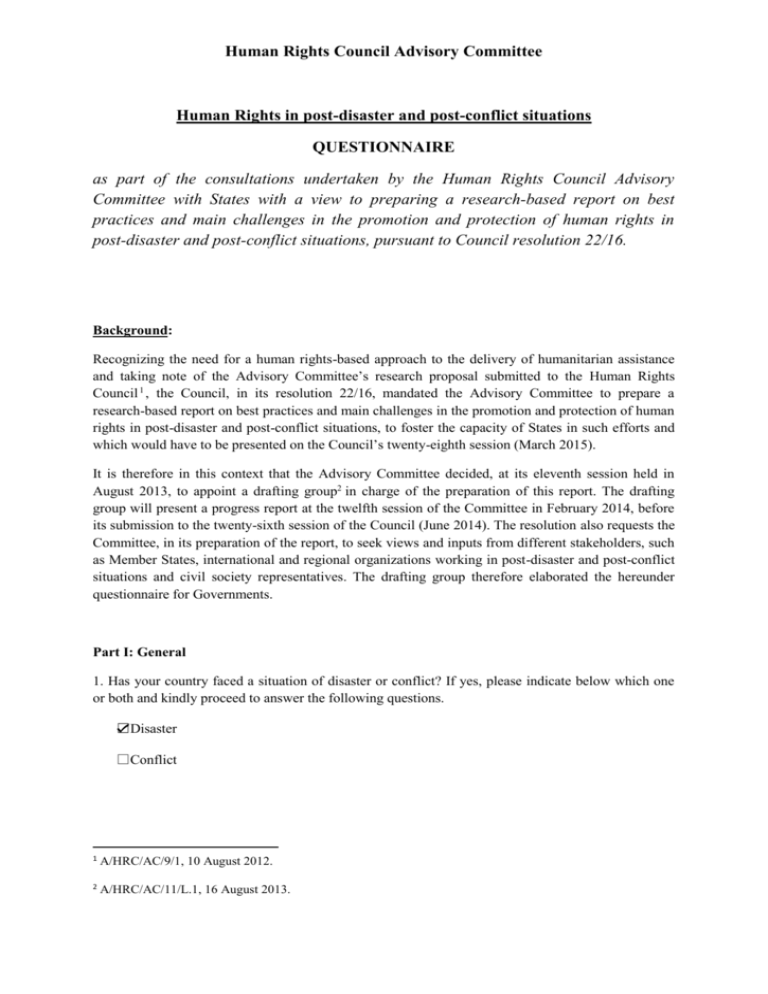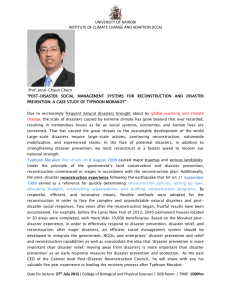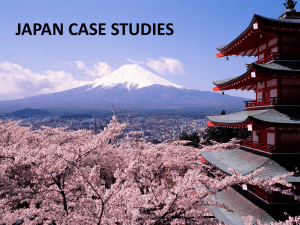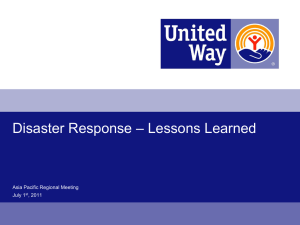Human Rights in post-disaster and post
advertisement

Human Rights Council Advisory Committee Human Rights in post-disaster and post-conflict situations QUESTIONNAIRE as part of the consultations undertaken by the Human Rights Council Advisory Committee with States with a view to preparing a research-based report on best practices and main challenges in the promotion and protection of human rights in post-disaster and post-conflict situations, pursuant to Council resolution 22/16. Background: Recognizing the need for a human rights-based approach to the delivery of humanitarian assistance and taking note of the Advisory Committee’s research proposal submitted to the Human Rights Council 1 , the Council, in its resolution 22/16, mandated the Advisory Committee to prepare a research-based report on best practices and main challenges in the promotion and protection of human rights in post-disaster and post-conflict situations, to foster the capacity of States in such efforts and which would have to be presented on the Council’s twenty-eighth session (March 2015). It is therefore in this context that the Advisory Committee decided, at its eleventh session held in August 2013, to appoint a drafting group2 in charge of the preparation of this report. The drafting group will present a progress report at the twelfth session of the Committee in February 2014, before its submission to the twenty-sixth session of the Council (June 2014). The resolution also requests the Committee, in its preparation of the report, to seek views and inputs from different stakeholders, such as Member States, international and regional organizations working in post-disaster and post-conflict situations and civil society representatives. The drafting group therefore elaborated the hereunder questionnaire for Governments. Part I: General 1. Has your country faced a situation of disaster or conflict? If yes, please indicate below which one or both and kindly proceed to answer the following questions. ☑Disaster □Conflict 1 A/HRC/AC/9/1, 10 August 2012. 2 A/HRC/AC/11/L.1, 16 August 2013. As submitted Part II: Post-disaster situations 1. Does your Government have a specific mechanism to deal with disasters? Does it have operational guidelines on a human rights-based approach in such situations? Which human rights do you focus on? One of the systems to address disasters is the Disaster Countermeasures Basic Act. It was revised after the Great East Japan Earthquake, which caused devastating damage. Based on the revision, measures for protecting affected people were enhanced as below. 1) In addition to designating shelters for emergency evacuation purposes, mayors of municipal governments are to designate facilities to ensure a basic standard of living for evacuees regarding the shelters where those affected are expected to stay for a certain period of time. 2) Mayors of municipal governments are able to develop a database of affected population, which includes information on support and assistance provided to the affected people. 3) A system to temporarily advance the rescue-support cost through the national government is to be developed. Moreover, the Nuclear Regulation Authority of Japan has developed new Guidelines on Nuclear Emergency Preparedness. The Guidelines specify operational and technical matters related to evacuation and so called “off-site emergency zones”, which are (to be) designated around each nuclear power plant, with a view to facilitating the development of effective counter measures for disasters. 2. How does your Government ensure transparency and accountability in disaster responses and post-disaster recovery (including in connection with food distribution, building and infrastructure reconstruction)? With regard to information on disasters and disaster response, the Cabinet Office gathers information from relevant ministries and agencies, and publishes and disseminates it widely to the public through websites, etc. Regarding the acceleration of reconstruction, which is a top priority of the Abe Cabinet, the Reconstruction Agency explains policies and measures including through holding a regular (twice a week) press conference and providing information on its website in order to ensure its transparency and accountability. For instance, with regard to rebuilding of housing, the Reconstruction Agency has been working to enhance the visibility of its progress as a part of its efforts to implement Measures to Accelerate Rebuilding of Housing and Town Development for Reconstruction. This effort aims to support accelerating reconstruction of society by raising public awareness of the reconstruction process by 2 As submitted releasing information on the current progress and future prospects of house rebuilding for the disasteraffected residents. As of September this year, the Reconstruction Agency has launched “the Tsuchioto Information Center”, a website on the Internet where information on each reconstruction project is available such as an overview of the projects, photos of sites taken by fixed point cameras, time schedule of construction, maps of sites, etc. For the purpose of facilitating access of the public to the above mentioned information, a common logo referred to as “Marufuku log” has been introduced on websites of relevant agencies and local governments. People can easily have access to the latest information on the progress made on reconstruction simply by clicking on it. On the occasion of the Great East Japan Earthquake, the Ministry of Economy, Trade and Industry (METI) adjusted supplies of daily-use goods such as generators and blankets to the victims of the earthquake, following the requests received from the affected prefectures through the Headquarters for Major Disaster Management. In adjusting supplies, the METI worked closely with relevant industry associations, manufacturers, and distribution firms. METI released public updates of the measures taken in response to the disaster in press briefings and on its website in order to ensure transparency and regularly disclosed relevant information such as the relief requests to the relevant industry associations, the situation of afflicted areas, the names of METI’s division in charge of distribution of goods as well as of those firms that volunteered to cooperate. 3. What specific attention, if any, do you give to the needs of the following groups: children, women, indigenous peoples, elderly, persons with disabilities, minorities, non-citizens, including migrant workers? The Disaster Countermeasures Basic Act was revised in June 2013, and it now stipulates the obligation for mayors of municipal governments to develop “Databases of People Requiring Assistance for Disaster Evacuation,” which are lists of vulnerable people such as elderly people, people with disabilities, infants and babies for whom special care should be taken in disaster countermeasures. Additionally, the Act establishes the system to ensure the sharing of information in the aforementioned database between mayors and assistance providers at local and regional levels including fire-fighting agencies and social workers. Also, with a view to ensuring that the work of local governments adequately responds to the revisions made to the Act, the Government of Japan developed and published the Guidelines of Evacuation Assistance for People Requiring Assistance during Disaster for municipal governments. In addition, a newly-added provision in the Act requests municipal governments to make reasonable efforts in ensuring living conditions in shelters. To this end, the Guidelines for Action toward Ensuring Sound Living Environment in Shelters has also been elaborated and published mainly for municipal governments in their managing of shelters, identifying areas where special attention is necessary in assisting the vulnerable people including persons with disabilities. 3 As submitted The Gender Equality Bureau of the Cabinet Office issued in May 2013 the Guidelines for Disaster Prevention and Reconstruction from a Gender Equality Perspective, presenting basic guiding principles based upon disaster experiences of the past including Great East Japan Earthquake in 2011, for local governments to take actions and respond from a gender equality perspective in prevention, emergency, recovery, reconstruction, and other stages. 4. What protections/standards do you have in place to ensure non-discrimination and respect of the humanitarian principles of humanity, neutrality, impartiality and independence in the provision of services, relief, etc.? The second paragraph of Article 2 of the Disaster Countermeasures Basic Act stipulates the basic idea for addressing disasters as below. 1) A post-disaster situation should be understood as accurately as possible after its outbreak. Based on the information, the protection of human lives must be the first priority to be realized by appropriate allocation of personnel, goods and other necessary resources. (Item 4) 2) Affected people should be supported appropriately according to various disaster-recovery phases and based on the characteristics of the affected people such as their age, gender or handicap, attention being given to avoid hampering proactive efforts by themselves. (Item 5) 5. Please give examples of culturally-relevant/responsive responses and actions, e.g. in terms of food, clothing, etc., and of religiously relevant/responsive responses and actions, including separate facilities for men/women, facilities for worship, clothing, food. In managing shelters, Fukushima Prefecture has made various efforts to provide culturally relevant/responsive post-disaster support, giving due consideration to cultural life of evacuees, which include the following: - Took measures to ensure as much privacy as possible to evacuees - Provided meals prepared by professionals - Implemented routine inspections by public health workers - Organized study groups led by college students for elementary and junior high school students, - Secured a playing space for kids. Fukushima Prefecture also secured a space for women and girls by reserving a room in shelters. The Fukushima Gender Equality Centre supervised the operation of such a space with assistance from volunteer groups. This space aimed to provide women with a place where they can stay with security and comfort. Women living in the shelter have been able to talk to staff about their worries, and staffs 4 As submitted also helped them receive special assistance from specialised counselling organizations in case of, inter alia, domestic violence and sexual abuse. 6. What are the main challenges you face in applying protection and promotion of human rights in post-disaster situations? On the national level, the Human Rights Organs of the Ministry of Justice provide human rights counselling services through the Legal Affairs Bureaus, the District Legal Affairs Bureaus and their Branch Bureaus. If the Organs recognize, through the complaints of the victims, etc., a case in which human rights infringement is suspected, they conduct investigations and take appropriate measures to protect the rights of the victims. Special counselling offices have been set up in the affected areas, providing counselling services in the area of human rights to people affected by the Great East Japan earthquake. Moreover, the Organs posted the emergency messages on the webpage of the Ministry of Justice and have implemented various promotion activities such as holding symposiums, displaying posters and distributing flyers to prevent human rights infringement including discriminative treatment based on rumors about radiation exposure caused by Fukushima Daiichi Nuclear Power Station. At the regional and local levels, main challenges identified by Miyagi Prefecture, one of local governments severely affected by the Great East Earthquake in March 2011, are as follows: - Severely afflicted coastal areas have high percentage of elderly population. As aging is progressing, measures should be taken so that the elderly can continue to live healthy lives. - Victims are often mentally cornered, because in many cases, they lost their family, friends or relatives. A mechanism to follow their physical and mental health should be established. Preventive measures should also be taken for those whose problems have yet to be surfaced. - Former communities were destroyed due to the earthquake and tsunami, and residents are now forced to live in a totally new environment such as a temporary housing unit. Although the victims are expected to build a new community themselves, not all people can adjust themselves to a new environment. Therefore, measures to help rebuild local communities should be elaborated. 7. What best practices can you mention in the promotion and protection of human rights in post-disaster situations? 1) In Fukushima Prefecture Examples of best practices in the promotion and protection of human rights in Fukushima Prefecture after the Great East Japan Earthquake in March 2011(M9 earthquake) are as follows: 5 As submitted -Arranged routine visits of public health workers, welfare workers, registered dieticians, and dental hygienists to shelters and temporary housing units so that the prefecture can keep track of the residents’ health conditions as well as provide them with health counselling. -Regularly conducted a health survey on all Fukushima residents to follow health implications of radiation after the Fukushima Daiichi Nuclear Power Plant accident. The survey aims to keep track of and promote residents’ health conditions from a long term perspective. -Provided residents with opportunities, such as parents-and-kids classes and cooking classes, to facilitate interactions with each other as well as between parents and children. -Helped to create indoor playgrounds for kids. (They cannot play outdoors as much as they wish due to fears of radiation.) -Gave support to various children’s programs, aiming to provide them with opportunities to interact with one another and fully enjoy the natural environment in a relaxed manner. -Continued to raise awareness by providing correct information on radiation and promoted human rights, following news reports immediately after the Fukushima Daiichi nuclear accident that some of the evacuees from Fukushima were refused lodging at hotels in other prefectures, and evacuated children faced discrimination in their new schools. --With an aim of hiring disaster-affected populations in projects to build new communities in temporary housing units and thereby assisting to rebuild their lives, implemented various measures including providing shopping and other assistance for persons with disabilities and others in need, the opening of information stations, publishing Kizuna (bond) newspaper and organising summer festivals, 2) In Miyagi Prefecture Cities, villages, non-political organizations and others including individual volunteers have been extending a wide range of assistance to the victims of the earthquake including the following: - Assistance related to health: An exercise class has been offered to those who moved to a temporary housing unit. The residents tend to have less exercise thus have higher risk of disuse syndrome. The class aims to introduce more exercise in their everyday life and prevent to lower activities of daily living (ADL). - Countermeasures against suicide: There had been training for volunteers on suicide prevention and they had implemented activities to counter suicide. (These activities were suspended after the earthquake.) The volunteers resumed their work since September 2011 mainly in an assembly room at the temporary housing units. - Building of local communities: Playgrounds with large playing equipment have been constructed. Creating such a playground can attract children as well as parents, facilitates their interaction, and can be a starter for building a new community. 6 As submitted 8. What specific measures, if any, do you apply to ensure transparency in the implementation of funds for disaster relief? Based on the Disaster Relief Act, the Government disburses its budget for affected people through prefectural governments, and secures transparency by auditing. <End> Part III: Post-conflict situations 1. Does your Government have a specific mechanism to deal with post-conflict situations? Does it have operational guidelines on a human rights-based approach in such situations? Which human rights do you focus on? 2. How does your Government ensure transparency and accountability in post-conflict recovery (including in connection with food distribution, building and infrastructure reconstruction)? 3. What specific attention, if any, do you give to the needs of the following groups: children, women, indigenous peoples, elderly, persons with disabilities, minorities, non-citizens, including migrant workers? 4. What protections/standards do you have in place to ensure non-discrimination and respect of the humanitarian principles of humanity, neutrality, impartiality and independence in provision of services, relief, etc.? 5. Please give examples of culturally-relevant/responsive responses and actions, e.g. in terms of food, clothing, etc., and of religiously relevant/responsive responses and actions, including separate facilities for men/women, facilities for worship, clothing and food. 7 As submitted 6. What are the main challenges that you face in the promotion and protection of human rights in postconflict situations? 7. What best practices can you mention in the promotion and protection of human rights in postconflict situations? 8. Do you do have a specific mechanism to assure peace building and transitional justice? 9. What are the main challenges you face in peace building and transitional justice? 10. What best practices can you mention on peace building and transitional justice? Deadline for submission of responses to the questionnaire: In order to give the Drafting Group the opportunity to take into account the different contributions, all parties are encouraged to submit their responses as soon as possible and at the latest by 8 November 2013. Answers can be submitted via email to the following address: hrcadvisorycommittee@ohchr.org OR Secretariat of the Human Rights Council Advisory Committee c/o Ms. Dina Rossbacher Office of the United Nations High Commissioner for Human Rights Palais Wilson, Room 4-065, Fax: +41 22 917 9011 United Nations Office at Geneva, CH-1211 Geneva 10, Switzerland Thank you for your contribution. For more information on the Advisory’s mandate: http://www.ohchr.org/EN/HRBodies/HRC/AdvisoryCommittee/Pages/HRCACIndex.aspx 8








